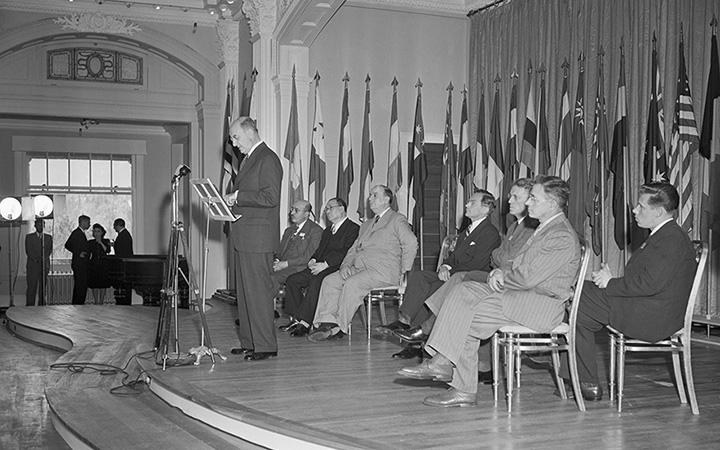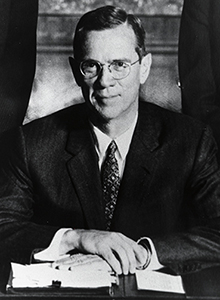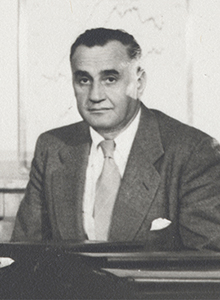Launch of the Bretton Woods System
1958

In July 1944 at Bretton Woods, New Hampshire, the forty-four countries constituting the Allies fighting the Axis powers constructed a blueprint for the post-World War II international monetary system. Reflecting the perception at the time that the Depression-era "competitive devaluations" of currencies undertaken by countries such as the United States and Great Britain had destabilized international trade, the founders envisaged a system of pegged exchange rates. However, as a reflection of the concerns of John Maynard Keynes that balance-of-payments deficits could force countries such as Great Britain to make their goods cheaper through deflation, and thereby creating high unemployment, the International Monetary Fund (IMF) Articles of Agreement allowed countries experiencing balance-of-payments deficits because of fundamental disequilibrium to devalue their currencies.
But because countries initially maintained exchange controls after the war, the free convertibility of one currency into others at the pegged exchange rates required by the Bretton Woods system remained an ideal. The overwhelming concern was that of a "dollar shortage," that is, European countries in particular lacked the dollars required to import food and energy necessary to prevent the collapse of their war-ravaged economies. The United States dealt with these fears by encouraging the European countries to devalue their currencies relative to the dollar, thereby increasing their net exports and earning dollars that eased the dollar shortage. As a result, they did not have to submit to deflation to return to convertibility. In fact, these devaluations left the dollar overvalued, that is, US goods appeared expensive to the rest of the world. The United States then incurred a deficit in its international balance of payments. With the dollar pegged to gold, it lost gold when it settled the deficit. Initially the United States acquiesced because it had accumulated most of the world's monetary gold reserves during the war.
The Bretton Woods system became operational in 1958 with the elimination of exchange controls for current-account transactions. Although the United States continued to run current-account surpluses, heavy investments by residents of the United States in Europe produced an overall deficit in the balance of payments and gold outflows intensified. The intention had been for the system to mimic the working of the gold standard: With member countries pegging their currencies to the dollar and the United States pegging the value of the dollar to gold at $35 per ounce, gold outflows from the US would require contractionary monetary policy.
Specifically, in order to counter the loss of gold by attracting inflows of funds, the Federal Reserve would have to raise interest rates. The money stock would contract and ultimately the price level would fall. Goods made in the United States would become more competitive and an international payments deficit would turn into a surplus. In this spirit, the Fed raised interest rates in early 1960 and money (M1) declined over the years 1959 and 1960. Only three years after the 1957-1958 recession, in 1960, the United States again entered into recession. Because of the concern within the Kennedy administration to avoid a run on the dollar, the Treasury and the Fed combined forces to maintain a cautious monetary policy heedful of international payments imbalances.
The policymaking environment changed drastically with the transition from the Kennedy to the Johnson administration in 1963. The passage of the Kennedy tax cut in 1964 signaled a political consensus in favor of a national policy to achieve full employment, almost universally taken to be a 4 percent unemployment rate. With this focus on domestic economic conditions, political pressures made it nearly impossible for the Fed to raise interest rates for balance of payments reasons. In order to deal with payments imbalances, the United States turned to capital controls. The Department of Commerce limited foreign direct investment and the Fed limited bank lending abroad. In 1968 central banks stopped buying or selling gold in the open market. Only foreign central banks could then ask the US Treasury for gold. This changed the Bretton Woods system from a de facto gold standard anchored by a fixed dollar price of gold into a dollar standard.
With a dollar standard, the price levels of the other countries in the Bretton Woods system had to move in line with the price level in the United States. Given the overall expansionary and inflationary monetary policy in the United States that started in 1964, foreign countries had to inflate along with the United States. Apart from France, the United States successfully pressured other countries not to present dollars to the US Treasury for payment in gold. Other countries then held on to the dollars they accumulated from US payments deficits. When presented to the central banks of those countries for their own currency, those dollars pushed up their bank reserves and money stock. Inflation in these countries then increased along with US inflation.
In August 1971 President Nixon imposed price and wage controls, closed the gold window to foreign central banks, and imposed a surcharge on imports. In order to spur US exports and American jobs, he demanded that US trading partners revalue, that is, increase the value of their currencies relative to the dollar. The opposite side, a devalued dollar, would make US exports more attractive. The export industries in foreign countries protested to their governments because their exports would decline as they become more expensive. However, the threat of dollar devaluation caused holders of dollars to flood the foreign exchanges to purchase foreign currencies whose value could only increase.
Initially, foreign countries resisted revaluation of their currencies and instead imposed exchange controls to prevent this inflow of dollars, but these controls worked poorly. As explained above, foreign central banks had to monetize these inflows and allow inflation in order to maintain the fixed peg with the dollar (to prevent appreciation of the foreign exchange value of their currencies). The industrialized countries of the G-10 negotiated at the Smithsonian in Washington, DC, in December 1971. In return for eliminating the surcharge the United States had imposed on imports, other countries agreed to an effective devaluation of the dollar of about 10 percent. However, the Fed undermined the effect of the devaluation by continuing to lower interest rates in pursuit of the domestic policy objective of full employment. Instead of the anticipated return flow of dollars to the United States, dollars continued to flow out and foreign central banks had to continue monetizing the dollars presented to them.
Speculative pressure against the dollar abated in the last half of 1972, but then resumed in early 1973. When confronted with monetizing massive dollar inflows in March 1973, foreign governments let their currencies float, effectively ending the Bretton Woods system.
Bibliography
Bordo, Michael D. "The Bretton Woods International Monetary System: A Historical Overview." In A Retrospective on the Bretton Woods System: Lessons for International Monetary Reform, edited by Michael D. Bordo and Barry Eichengreen, 3-108. Chicago: The University of Chicago Press, 1993.
Hetzel, Robert L."German Monetary History in the Second Half of the Twentieth Century: From the Deutsche Mark to the Euro." Federal Reserve Bank of Richmond Economic Quarterly 88 (Spring 2002), 29-64.
Hetzel, Robert L. The Monetary Policy of the Federal Reserve: A History. Cambridge: Cambridge University Press, 2008 (Chapter 9).
Solomon, Robert. The International Monetary System, 1945-1981. New York: Harper & Row, 1982.
Yeager, Leland B. International Monetary Relations: Theory, History and Policy. New York: Harper & Row, 1976.
Written as of November 22, 2013. See disclaimer and update policy.



 X
X  facebook
facebook
 email
email